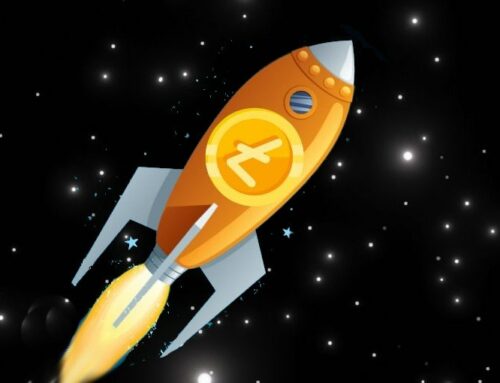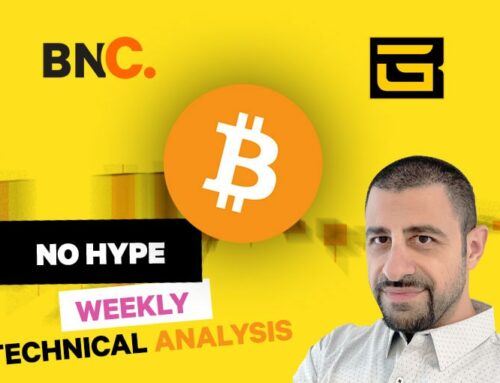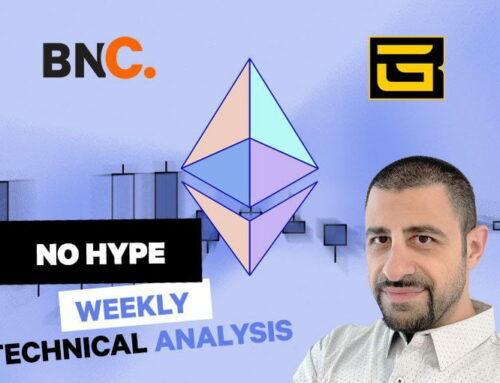LUNA Analysis – Why is LUNA the latest token to land on the moon?
LUNA, the native token of the Terra smart contract platform, is one of the best-performing assets in crypto since the beginning of 2021, up a staggering ~10,400%. What’s behind LUNA’s successful mission to the moon?
Terra (LUNA) is a smart contract-based blockchain protocol used for issuing algorithmic stablecoins and Decentralized Finance (DeFi) infrastructure. LUNA is the native token of the platform and is used for collateral and price stabilization of the platform’s stablecoins.
Since the beginning of 2021, the price of the asset is up a whopping ~14,517%. From trading for ~US$0.65 on January 1, 2021, the price of each individual LUNA is now ~US$95.26, just below the all-time high of ~US$120 achieved on April 5th, 2022.
At the start of 2021, LUNA was the 62nd largest asset in crypto with a market capitalization of US$321.3 million. It is now the 8th largest asset in crypto and has a market capitalization of US$33.6 billion. A rise in value of 10,400%.
LUNA has also significantly outperformed the rest of the crypto market in recent months. Since the beginning of February, the price of LUNA has risen by ~74%. From trading at US$52.13 on February 1st, LUNA now trades for US$90.61. Over the same period, the price of Bitcoin (BTC) is ~8%, Ethereum (ETH) is up 17%, and Solana (SOL) is up ~2%.
Since 2021, platform blockchains like Terra have captured the imagination of crypto investors. Retail investors, traders, and venture capitalists are throwing money at projects hoping to find the next Ethereum, the original smart contract blockchain. Projects like Solana, Avalanche, and Fantom have achieved escape velocity by creating functional use-cases and improving on Ethereum’s fees and transaction times. Terra has stood out from a number of competitors because of its unique native stablecoin design and high yield DeFi offerings.
The larger mission of the Terra blockchain is to create a stablecoin-based ecosystem where users can easily pay merchants with crypto, earn a steady interest on crypto deposits, and in general create a platform where everyday banking services are replaced with digital, blockchain-based solutions.
The Terra blockchain
Terra was developed by South Korea-based Terraform Labs, which was founded in 2018 by Do Kwon and Daniel Shin. Kwon, who now runs the development house, was previously employed by Microsoft. Shin is the founder and CEO of Asian payment technology company, Chai. Chai is partnered with Terra to enable blockchain stablecoin payments.
Terra is a proof-of-stake blockchain that is powered by the plug-and-play Cosmos SDK blockchain architecture. It is managed by a consensus/transaction confirmation model known as Tendermint.
Cosmos SDK can be understood as software that crypto startups can license for building their own blockchain ecosystems. It allows teams to significantly speed up development times and focus on economics and products, while the blockchain architecture is outsourced. Cosmos SDK and Tendermint allow for fast and cheap transactions but sacrifice decentralization.
Source: Cosmos
_How Cosmos SDK-based blockchains compare to other blockchain architectures. Source: Twitter user @rareliquid _
With the Tendermint consensus, a validator called a proposer submits a block of transactions. Other validators in the network vote in two rounds on whether they accept or reject the proposed block. If a block is rejected, a new proposer is selected and the process starts again. If accepted, the block is signed and added to the chain.
Transaction fees from the block are collected and then distributed as staking rewards to validators and delegators. The original proposer gets an additional reward for his service.
With Terra there are two participants in PoS consensus. Validators and delegators. The latter is anyone that holds LUNA and would like to take part in securing Terra but does not want to go through the hassle of setting up a staking node. Delegators choose 1 of the 130 validators participating in the Terra ecosystem to delegate their Luna too.
In return they will receive a portion of validator rewards, and also airdrops from Terra protocols like Mirror and Anchor. To participate in consensus, individuals who delegate and validate have to bond LUNA, locking it into the network. Once bonded LUNA cannot immediately be sold. If a staker chooses unbonded, their LUNA remains locked for 21 days. During this period, rewards on LUNA are not earned.
_The total amount of staked LUNA and returns for stakers. About 43% of the total LUNA supply is now locked into staking. _
The Terra ecosystem
_Total value locked into the Terra Blockchain. Source: DeFi Llama _
The total value of assets currently locked into Terra sits at ~US$13.1 billion. This value has risen by an enormous ~194% in the last 6 months, a period during which the TVL on other major smart contract platforms has dropped off. In the last 6 months, the TVL of Ethereum has dropped by ~19%.
_The share of Total Value locked amongst the largest players in the platform blockchain space Source: Defi Llama _
In 2022 Terra has risen to become the 2nd largest blockchain by total USD TVL value. The growth of the protocol stands out as does the number of protocols built on Terra, just 26. There are 100s of protocols built on top of both Ethereum and the Binance Smart Chain (BSC).
The Terra vision
Terra is most well known for its stablecoin strategy and the decision to issue its own stablecoins, such as Terra US Dollar (UST), rather than use one that is already in existence. Most other platform blockchains that have arrived after Ethereum transfer an existing stablecoin with built-in architecture from other blockchains when they first launch.
There are, for example, versions of USD-Coin (USDC) on the Solana, Algorand, and Stellar blockchains. There are even more options for Ethereum Virtual Machine (EVM) chains because the smart contracts for Ethereum-based stablecoins like USDT and DAI can very easily be ported.
Stablecoins are the essential glue that holds together the Decentralized Finance ecosystem. Users need a shield to protect themselves from the inherent volatility of the crypto markets.
This is especially the case for newly launched smart contract chains, and users of volatile assets like AVAX, FTM, or SOL. It is essential that there is a stable haven that can be used for liquidity and jumping between DeFi apps.
The Terra strategy of issuing its own stablecoins is brave because the existing stablecoins already have some history of dealing with regulators. UST has had to establish its own reputation and regulatory position from scratch.
Terra’s stablecoin is woven deeply into the ecosystem, with the supply of the platform’s native token LUNA being underpinned by demand for UST stablecoin.
Terra has been able to bootstrap its growth and hit escape velocity thanks to a laser-pointed focus on four key initiatives:
- Growing the aforementioned UST stablecoin which uses a dual token, LUNA-UST, supply mechanism which harkens the DAI-MKR relationship.
- In-house apps, Anchor and Mirror, to create a place to use the UST stablecoin and build demand for it.
- Cross-chain bridging capabilities powered by the Cosmos Inter-Blockchain Communication (IBC) Protocol framework.
- Hype surrounding UST integrations with CHAI and Moonpay, two popular payments in Korea and Mongolia respectively, to create a real-world payments use case for UST.
On November 9th, a proposal passed which greenlit the ‘burning’ of 88.7 million LUNA tokens. With this burn, however, tokens were not removed from circulation. They were used to buy UST.
The burning took place over the next two weeks and created significant upward price pressure for LUNA because of the supply shock it created. With significantly less LUNA circulating and demand to use LUNA marginally rising, the price of LUNA shot up.
A large portion of the revenue from the burn, the new UST, will go towards funding new ancillary Terra services. These will include Ozone, an insurance mutual protocol that facilitates levered coverage of technical failure risks in the Terra DeFi ecosystem. The November LUNA burn is one of the biggest ever conducted by a layer 1 blockchain protocol.
The LUNA burn mechanism has acted as a dividend to backers of the Terra project. As the ecosystem has grown through demand to use UST and the Terra Ecosystem, holders of LUNA have consistently been fed through regular burns.
LUNA and UST: A seigniorage powered two token ecosystem
US Dollar Terra (UST) is an algorithmically pegged stablecoin that uses a mint-and-burn mechanism with Luna and UST as its levers. The protocol contracts and expands the supply of the two tokens to ensure UST maintains its 1-to-1 peg with the US dollar.
If the price of UST is above US$1 because of excess demand, then the supply of UST needs to expand to dilute the price. Terra lets arbitrageurs turn in LUNA for UST worth US$1, even though the price of UST is more than US$1. Terra then burns the LUNA handed in by the arbitrageurs and the supply of LUNA drops. The buying pressure for UST pulls it back towards the peg. Increased demand for UST creates a supply shock for
The reverse occurs when the price of UST is below US$1. In this case, the supply of UST needs to be constricted to make up for reduced demand. Terra will then let arbitrageurs mint LUNA which can be swapped for UST worth US$1 even though the price of UST is less than 1 dollar. In this situation the supply of LUNA increases.
In both of these scenarios, the arbitrageurs pocket the difference created by the market inefficiency.
The LUNA token is minted and burned based on the demand and supply of UST. The model appears quite odd at first glance. An unbacked asset, UST, is used to mint a new supply of a volatile asset LUNA. LUNA’s price is a function of UST demand.
This model in some ways resembles the one used by traditional fiat-backed stablecoins. With US dollar stablecoins such as US Dollar-Tether (USDT) and USD-Coin (USDC), the issuer will always allow for 1-for-1 redemption between the stablecoin and physical US dollars held in reserve. Similarly, arbitrageurs are able to maintain the peg and pocket the difference by going between the market price of the stablecoin and the peg price offered by the issuer.
There are more clear risks associated, however, with the UST-LUNA model. The fiat-backed stablecoins hold actual US dollars in reserve. There is guaranteed redemption with UST.
If the price of UST drops because of a fall in demand, and the price of LUNA is falling at the same time, the amount of new LUNA that would need to be minted to maintain the peg will continue to rise. A death spiral may occur and since UST is not backed by anything, the situation would lead to a complete loss of funds.
What is essential to the health of the dual-token ecosystem is the price of LUNA remaining high. So far so good on this front, given the tremendous rise in the value of the token over the last year. There are a number of factors as to why LUNA has retained its value so well over this period.
As a proof of stake blockchain, Terra needs its validators to stake LUNA to secure the network. Since Terra validators have to lock in LUNA for long periods, they also absorb volatility. It is harder for them, compared to retail speculators, to sell out on holdings because they are staked to the network. FIipside crypto reports that ~34.8% of the circulating supply of LUNA is staked.
As a trade-off, validators and delegators earn benefits for their commitment to the network. They receive a share of gas fees collected for each transaction and they earn. Despite being designed as a high throughput network, Terra charges gas fees to prevent transaction spamming.
For every mint-burn LUNA-UST transaction Terra also charges a 0.5% fee. This also goes to validators and delegators.
Finally, LUNA proof-of-stake participants earn Seigniorage rewards. Seigniorage is the value of the currency minus the cost of producing it. In the case of UST, the value of each UST is US$1 but the cost of producing each one is close to 0. Seigniorage profits are collected each week by Terra and distributed to a community pool that funds Terra initiatives. The rest goes to a rewards pool. The rewards in the pool are distributed over the course of a year to encourage long-term commitment.
Seigniorage occurs when Luna is burnt to create more UST. This happens because there is an increase in demand for UST. This mechanism benefits current active stakers and validators of LUNA because it makes LUNA increasingly scarce and makes buying into proof-of-stake more expensive.
Source: https://terra.smartstake.io/ust
The chart above indicates that over the course of the last year, more LUNA was burnt to create more UST than vice versa. This means significantly higher Seigniorage rewards for stakers. The price of LUNA, as mentioned earlier, is driven by the demand for using UST tokens. Months where the supply of UST has grown the most, correlate with months when LUNA price gains have been highest.
Demand for UST has roared in recent months and the token has risen to become the 3rd largest stablecoin by Market Cap surpassing Binance-USD (BUSD) in the last week. The asset currently has a market cap of ~US$18 billion. At the start of the year the market cap was US$10.1 billion.
The key driver of LUNA’s recent price gains has been the continual burning of LUNA tokens to ensure that UST maintains its 1-to-1 peg to the US dollar. There have been numerous days in the past month when over a million dollars worth of LUNA has been burnt.
The daily burns create a supply shock and positive price pressure. If the demand to use Terra remains at least constant then the price of LUNA will rise. Demand to use Terra is driven by the use of its smart contract and commitment to the network by staking. Onchain data indicates that Terra is gaining new users and transaction volumes.
Source: Flipsidecrypto
Source: Flipside Crypto
The Utility of UST: Protocols like Anchor boost the power of Terra tokens
One Dapp, Anchor, accounts for ~53.5% of the TVL on Terra. Anchor is a yield farming/savings protocol. It is designed to offer a less volatile—but high—yield. Anchor generates this yield through a diversified stream of staking rewards earned from a number of different PoS blockchains. This is where it differs from 1.0 money markets in crypto like Compound where interest is based on the difference of demand and supply between borrowers and lenders of various crypto assets.
Anchor has touted that it can offer a fixed, not variable, 20% interest on US dollar stablecoins. A proposition that seems eye-popping and ponzi-esque at first because the national average interest rate for US savings accounts is just 0.06%, according to Bankrate data from November. This 20% fixed rate has been a key marketing tool for Terra and has helped to attract new buyers of UST.
Youtube goes mad talking about Anchor’s 20% APY
The current state of the Anchor ecosystem- A fixed 19.54 interest rate. Source: Anchorprotocol.com
Anchor generates its high interest by asking users to deposit Yield generating volatile assets. When depositing UST on Anchor, depositors also need to put up either Ether, LUNA, Avalanche (AVAX), or Cosmos hub (ATOM). With these assets, you can also take out an overcollateralized loan and borrow UST, which can then be used at the borrower’s discretion.
The ETH. LUNA, AVAX, and ATOM deposits generate a yield from using staking platforms like Lido Finance and Benqi. The ETH and LUNA deposited into Anchor are converted into Lido Finance’s bonded ETH (bETH) and bonded LUNA (bLUNA) standards.
There are currently US$6,214,679,869 worth of collateral assets deposited on Anchor. ~US$4.24 billion is LUNA, ~US$1.7 billion in ETH, 86.1 million in AVAX, and 9.38 million in ATOM.
Source: Lido.fi
The rate that LIDO offers for LUNA is 6.8% and the amount it offers for ETH is 3.9%. The rate that Benqi offers for AVAX is 7.2% and pStake offers 12% for ATOM So for the US$4.24 billion in LUNA, ~US$288.3 million is generated in yield per year. Earnt in native tokens.
The amount borrowed by Anchor users is 3,139,374,213, the interest they pay (at a rate 11.7% a year) would lead to revenue equal to ~366.2 million.
19.54% of US$12.7 billion is US$2.36 billion. The return across LUNA, ETH, AVAX, ATOM, UST yield and interest payments is designed to be more than enough to pay the 19.56% rate to UST depositors and also have a little bit of a float as protection.
A key design feature of Anchor is a treasury. During the good times, Any extra LUNA and ETH yield is used to top up the treasury. When markets are down, and users are withdrawing their volatile assets, the treasury is used to pay out UST depositors.
The demand to take advantage of the high yields on a US-Dollar equivalent drives users to Anchor. This drives up the demand for UST— the only stablecoin currently available on Anchor. As demand for UST grows, more LUNA is burnt to ensure that excess demand for UST does not cause the asset to rise above 1 US dollar. A bullish flywheel effect ends up with LUNA holders being the final beneficiaries.
TerraForm Labs, the team behind Terra, has even stepped in to inject $70mil from its Stability Reserve fund to continue paying the fixed APY. Other considerations to make the ecosystem more robust include increasing the max loan-to-value ratio to 60%, to allow more stakeable assets like Solana (SOL), Polkadot (DOT), and Cosmos (ATOM).
Terra’s Interoperability
The value of the Terra ecosystem and the value of the LUNA token has also been expanded thanks to the continued development of the blockchain’s bridging and interoperability capabilities.
With tools like Wormhole, users can now port digital assets between the Binance Smart Chain, Ethereum, Solana, and Terra networks with a single unified interface without the need to “double wrap” Terra tokens.
Bridges mean tokens don’t have to be wrapped before they can be used by other chains. Wrapping tokens refers to storing assets in a digital vault, so that equivalent versions of the assets (same price) can be used by other chains.
With bridging protocols like Wormhole V2 and Synapse, tokens can be moved around more freely between Terra and other blockchains. The costly and time-consuming process of wrapping can be foregone, opening up use cases across the blockchains.
Interoperability means tokens, NFTs, and price data can move between each other and communicate in ways they do not normally do. Governance, liquid staking, and oracle data reporting can now happen across supported blockchains.
Luna and Terra are tokens amongst the most transferred on Wormhole
Wormhole V2 arrived just after the release of the Columbus 5 upgrade. The upgrade included approval of the Cosmos Inter-blockchain Communication (IBC) protocol. IBC will let a variety of Dapps from other Cosmos-based blockchains be launched. IBC lets blockchains that adopt the protocol easily connect and communicate, allowing for the easy transfer of tokens between the chains that would not normally communicate with each other.
Do Kwon, the co-founder, and CEO of Terraform Labs, says that demand for UST in cross-chain environments will accelerate the expansion of the stablecoin’s supply. The MIM-UST stablecoin pool, on Curve Finance, for example, has a daily volume of US$74.1 million.
The cross-chain capabilities may turn into something of a double-edged sword for the Terra ecosystem. While having multiple cross-chain bridges definitely helps port liquidity across and allows users on other chains to more easily access LUNA and UST.
If there is ever a bearish flip because of a situation like a smart contract exploit and an extreme sell pressure scenario transpires, this might force the unstaking and further increase the sell pressure. There is a chance that the increased money velocity creates a further death spiral risk.
The other major issue with bridges is smart contract vulnerability. Bridging between blockchains is a complex operation with many moving parts. Wormhole, one of Terra’s most notable token bridges, was hit by a major exploit in February that resulted in ~120,000 ETH (Wrapped-Solana Ether) being stolen from the platform. The exploit occured because of a specific vulnerability on the Solana Wormhole contract. Certik, a smart contract auditing firm, said the same Wormhole exploit could occur on the Terra bridge.
Bridge hacks are black swan events that come out of nowhere, however, if they occur with frequency, users of these bridges should be aware of mishaps occurring because of the nascent technology. Cross-chain bridging will continue to be a part of the Terra model, as it attracts new DeFi users from other chains, and the chance of a major bridge hack looms over the project.
Legal troubles
Court filings from the Southern District of New York show that during October’s Messari Mainnet conference, Terra co-founder Do Kwon was served with Subpoenas by the Securities and Exchange Commission (SEC).
This information was revealed following a lawsuit filed by Kwon and Terraform labs. Kwon was served “two improperly issued subpoenas” and a failure to keep confidential an investigation into the Mirror Protocol.
The subpoenas stem from an investigation by the SEC into the Mirror protocol, a Dapp built on Terra by Terraform labs. The Mirror Protocol allows for the trading of Synthetic versions of real-world assets. Popular assets on Mirror include mTSLA, mNFLX and mMFST. Synthetic of US stocks that represent the companies Tesla, Netflix and Microsoft.
The mAssets on Mirror allow traders to bet on the price of stocks and commodities without having to physically hold them or use fiat currency to buy them. Tokenized stocks have often courted controversy and this is not the first time the SEC has come after the issuer of such a product.
In July 2020, US regulators, the Securities and Exchange Commission (SEC) and the Commodity Futures Trading Commission (CFTC) teamed up to issue Cryptocurrency investment platform Abra a joint fine.
The fine was issued despite Abra not offering its services to US-based customers. According to the SEC, Abra built an app that “enabled users to bet on price movements of U.S. listed equity securities.” After investigations, it found that “these contracts were security-based swaps subject to U.S. securities laws.”
Abra built a model that allowed users to deposit crypto as collateral to create synthetic assets.
“Businesses cannot ignore the registration requirements designed to provide investors with the information necessary to evaluate securities transactions,” explained Daniel Michael, Chief of the SEC Enforcement Division’s Complex Financial Instruments Unit, when assessing the Abra case. “Furthermore, businesses that structure and effect security-based swaps may not evade the federal securities laws merely by transacting primarily with non-U.S. retail investors and setting up a foreign entity to act as a counterparty, while conducting crucial parts of their business in the United States.”
What stands out about Kwon’s serving is that he was a foreign national. Generally, government agencies will opt to go through the more discrete option, and serve via a foreign national’s attorney.
Serving Kwon, in a public place in front of various industry peers at a major crypto conference was perhaps a signal that the SEC means business and meant to act as a deterrent for foreign companies seeking to build platforms like Mirror.
Conclusion
Terra has done an admirable job building a blockchain ecosystem that stands out from other Ethereum competitors. There has been a laser focus on building use-cases and value for UST and LUNA holders, who have been rewarded handsomely with capital gains and yield gains.
Seigniorage rewards for LUNA holders and high fixed interest rate returns on Anchor UST depositors are not something we observe on other smart contract blockchains. There is a fervor to buy into these initiatives. Blockchains like Waves and Near are jumping on this bandwagon to offer similar seigniorage-based stablecoin-native token reward models.
In recent times gains for LUNA have been pushed over the edge by large daily LUNA token burns that have been enormous supply shocks and have made each held LUNA more valuable as a result. Another tailwind has been a significant improvement in Terra-based tokens cross-chain interoperability thanks to the deployment of Wormhole and other initiatives.
Looking deeper into Terra, however, it becomes clear that this is a project that likes to take risks. Its ‘unbacked stablecoin powered by volatile native token model’ is more exposed to death spirals than other stablecoin models. Anchor’s ability to offer a fixed yield is also based on yields paid out to volatile assets.
While the crypto space is in a bull market and new wealth is constantly being churned, LUNA is better set up than other projects to take advantage of it. In a trendless market, demand for high UST yields has driven up the value of LUNA through burns. The project is defying market expectations. The high-risk strategy of Terra is paying off so far and LUNA is showing alpha value in both bullish and bearish leaning markets.

Don’t miss out – Find out more today

















